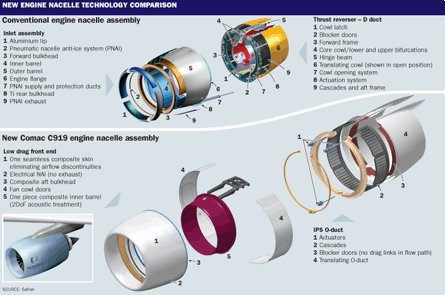While officials from China's Comac maintained a relatively conservative stance when selecting design features for their new 150-passenger single-aisle C919 airliner, they made at least one significant exception - picking a new company to wrap some tantalisingly new but unproven technologies around the aircraft's two CFM International Leap X1C engines.
The new company was Nexcelle, a joint venture between Aircelle, a Safran subsidiary, and GE's Middle River Aircraft Systems. The 50/50 teaming was modelled on the CFM joint venture between GE and Safran subsidiary, Snecma, that led to the development of the CFM56.
Nexcelle's offering - a nacelle, thrust reverser and exhaust system that envelope the Leap X1C engines - is unique not only because of the advanced technologies in the components, but because those components as a whole, given the close ties of the companies, can be optimised as the "world's first truly" integrated propulsion system (IPS), says Nexcelle.
 |
|---|
Click on image for full size version |
By working together CFM and Aircelle will be able to save weight and increase performance by cutting out the unnecessary conservatism that independent builders of the various systems typically include in their designs. That, combined with monolithic structures and flow-smoothing technologies will provide "multiple points" reduction in fuel burn as well as "triple-digit" weight savings, says Steve Walters, Nexcelle president.
Over a dozen new technologies are on tap, including a one-piece composite skin on the inlet, which eliminates flow disruptions compared with a typical multi-segmented aluminium lip. Woven into the forward section composites are resistive heating elements for engine anti-ice, removing the need for burst-resistant metal ducts to carry bleed air forward from the compressor.
Part counts have been reduced by low-maintenance monolithic structures like the one-piece composite "O" duct that surrounds the thrust reverser portion of the IPS, replacing the traditional two-piece "D" doors. Latches on the bottom of those doors have been a persistent maintenance issue, says Walters. By taking the "D" duct bifurcation out of the flowpath, Walters says IPS will have an increase in reverse thrust efficiency by up to 10%. The "O" duct will translate rearward for inspections at the push of a button.
Although Comac decided to keep pylon design in house, Nexcelle will be building a new engine mounting system that eliminates or reduces significantly the bending moment generated on the nacelle by the engine's thrust. "Typically this moment opens up clearances in the compressor section, reducing engine performance," says Walters.
The simplicity provided by the new structures has an added benefit in providing more surface area for acoustic treatments in the flow path, up to 80% coverage compared with 60-70% in a typical nacelle/thrust reverser system, says Walters. The IPS will include about 80% composite materials by weight, up from 70% on the Airbus A380, the most advanced system built by Nexcelle partner Aircelle. The C919 IPS will also use an electrically actuated thrust reverser system.
IPS components for the production line will come together with the engine and pylon at a new centre of excellence in Shanghai before first flight of the C919, expected in 2014. Nexcelle is planning a technology readiness demonstration of the IPS with a test engine in 2011.
Walters says Nexcelle is continuing its joint development phase activities with Comac until March 2011. CFM will be responsible for podding activity of the nacelle and engine at the centre of excellence during production.
Source: Flight International























